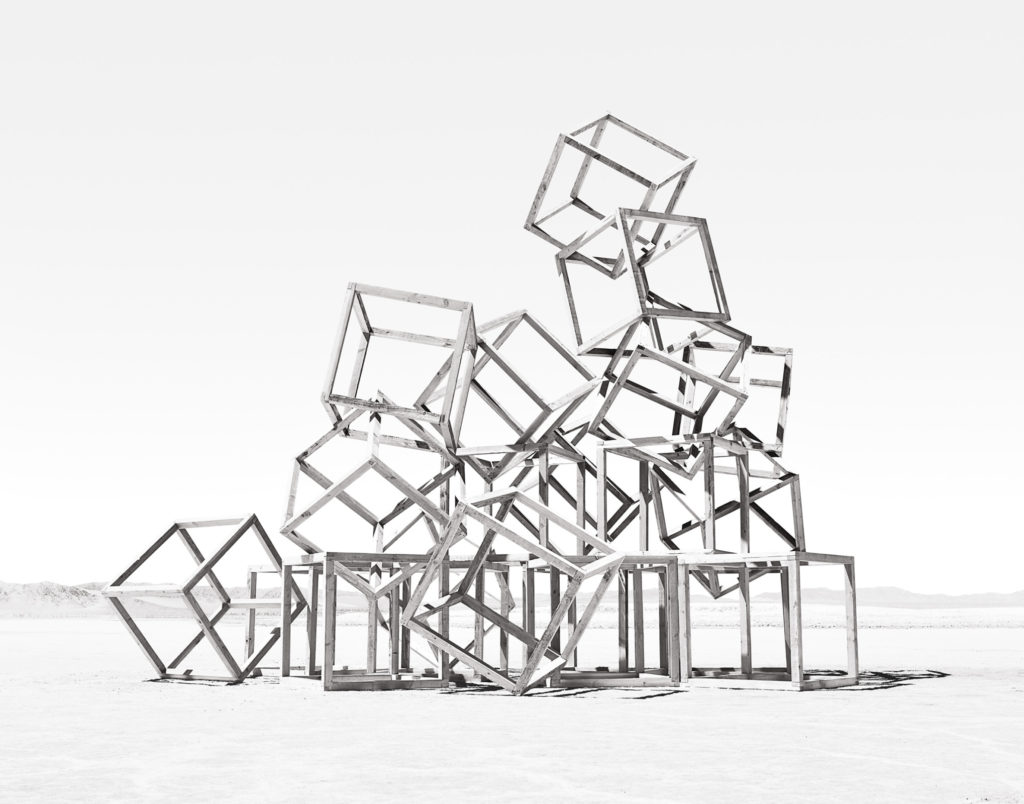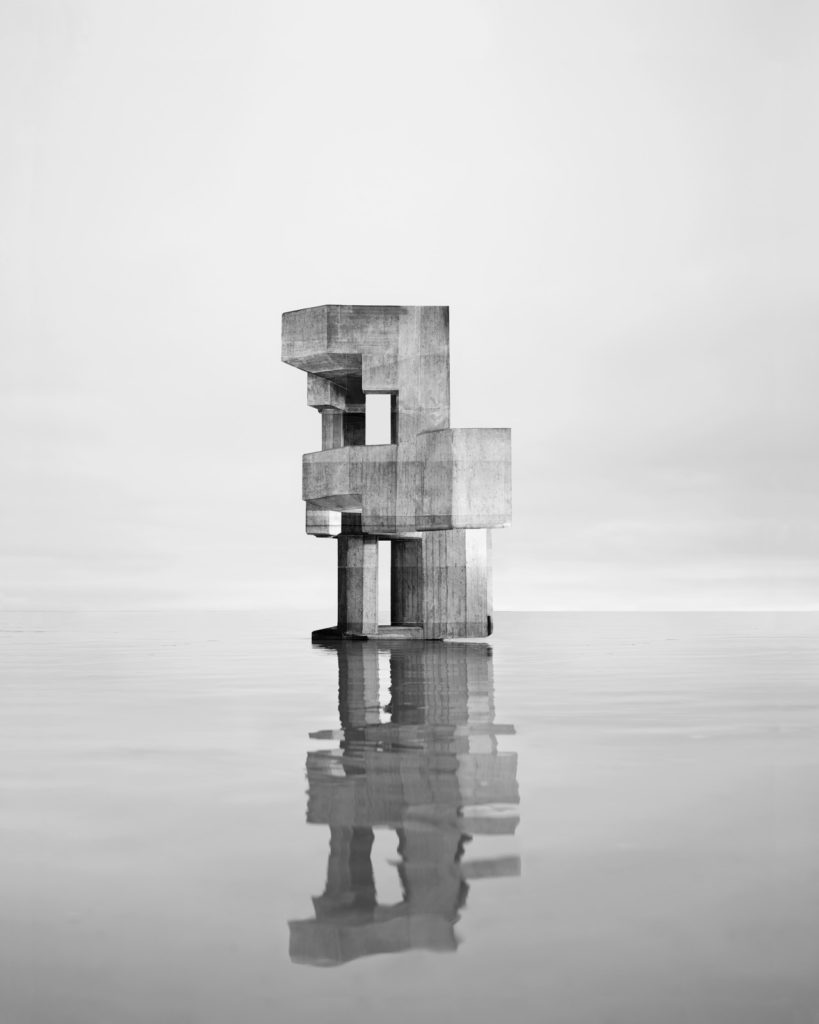Noémie Goudal’s impossible landscapes walk the line of ambiguity between regime of visibility and regime of truth. They question the photographic image’s potential and play a trick on the senses.
Noémie Goudal‘s sentient worlds are a source of illusion. Her architectural structures, solar eclipses and photographed observatories in the middle of nowhere question our relationship with the real and the imagined. Akin to Plato’s allegory of the cave, the artist gives us a truncated view of reality. She holds us captive to a visual trap for beauty, one which is simultaneously idyllic and stark. She turns us into the prisoners of deceptive photographic images, of imaginary worlds where the regime of visibility and the regime of truth collide and coincide.
Since 2010 the artist has tricked our senses and imposed a misleading belief. She has urged us to believe in a game between the imagined and the real. Having left Paris for London to study graphic design, then photography at the prestigious Royal College of Art, it was this year that marked a turning point in her work, with an additional backdrop making its way into her images. As part of a photographic project on one of northern Scotland’s mountainous islands, she had to capture reality a posteriori due to the weather conditions, particularly the wind, and photograph the images in the studio on her return to London. It is at this point that the illusion she submerges us in takes on its full meaning with regard to its Latin etymology illudere, i.e. to play, mislead, deceive. Both her photographs and installations distort our perception of reality. This is how the artist deceives us, showing us worlds torn between illusion and disillusionment.

Her creations disrupt the function of the senses and confuse the perceptual system. Her structures border on theatrical décor; meticulously crafted, unfurled then photographed in the middle of the countryside; by the sea; in sand and salt deserts; in the sky. They provide shared spaces in which to house our utopian visions. Yet her ‘heterotopias’, ‘these other places’, according to terms borrowed from Michel Foucault, have no geographical coordinates and only form part of a sentient cartography. They are merely optical illusions which question our relationship with space, the image, and the photographed sites themselves.

This is how the artist usurps reality, going one step further with this trick of the eye. For this, she incorporates her paper and wood constructions into the natural environment, leaving a visible trace of her intervention, of the structure of her work. Tape, creases, dividing lines and scale ratios: they all remain visible in her images. They give away the subterfuge. These deliberate markers from the artist reveal the artificial nature of the two-dimensional theatre props in her coastal observatories, telluric structures and diurnal skies, as well as her draped sheets which serve to open a window on deserted places. But the mystery remains unresolved in spite of these hints, which play with both the imaginary and the strength of our belief.



Our desire to believe is in fact stronger than any risk of disillusionment. Even if, as viewers, we are aware of the trompe l’oeil in front of us, we are knowingly taken in by its outward appearance, by the illusions that Noémie Goudal creates. Like castaways in search of a promised land, we want to believe that refuge lies in her images.
—————
For Gaston Bachelard: “We always want imagination to be the ability to form images. And yet it is rather the ability to distort the images garnered by perception; it is above all the ability to free ourselves from the original images, to change the images.” This quote seems to resonate perfectly with your creations. If you could reply to him, what would you say?
Yes, that is exactly the way in which I conceive my images. Imagination merges with reality, image or experience in order for it to fully exist. I really play on that in my constructions, I rely on it to “complete” the creations. It’s a team effort… In my exhibitions I also want the viewer to be caught up in this trajectory, in a movement that allows them to position themselves in front of the image, for the physicality of their body to be taken into consideration in their assessment of the images. This makes it possible, I think, to encourage the viewer to use their imagination when faced with the photos. The images obviously remain the same, but are open to completely different interpretations.
The process of creating your works is becoming increasingly monumental in scale. Are you able to share any secrets on the creative process, under the surface of your optical illusions?
Indeed, my photographs are always created by using installations in a natural environment, to a greater or lesser extent. I work with a small film crew. We build the installations and carry out tests for months before shooting. I very much enjoy working in a team and creating a special dynamic, with each person an expert in their respective field. It brings this great energy that I love experiencing on shoots, alongside a studio-based existence where I have more time to work on my own and carry out research.


In your latest creations you appear to be drawing our attention to climate change issues. Your Pressure project on the melting of the Rhone glacier in Switzerland is particularly revealing. Can you tell us more about it…
I certainly don’t seek to share any political or social viewpoints in my work — quite the opposite, I try to display images which are open to multiple interpretations. I try to construct images which have no geographical or temporal reference points and which lead to, by their very construction, a significant amount of interpretation. The viewer comes with their own experience and interprets the image in a context that is their own. One of the issues that I’m currently passionate about is the movement of an individual landscape and its choreography over the ages. These phenomena evolve in a very slow temporality, slower than ‘human’ time, which, in my opinion, forces us to view landscapes from a different angle; with the human being placed within a ‘whole’ rather than constituting ‘the whole’ alone. When looking at my images through the lens of the current context, the first thing that springs to mind is ‘the destruction of the environment’, but couldn’t the same images be viewed in a completely different way within a scientific, religious or past context, for example?
The images from Project Pressure are obviously presented in a very specific context, with the other images all evoking melting glaciers. This leads them to being interpreted in this way, but we also share a love of observing and of coming up with our own interpretation.


The risk of disillusionment seems eminently latent in your approach, as if hidden beneath the poetic beauty of your universe. Is this second level of interpretation intentional?
Yes, I think that an image is what it is, but it’s also what each individual makes of it. That’s why providing as many different types of interpretation as possible is very important to me. I like playing around with the seduction and attraction that an image can evoke, while simultaneously retaining its fragility, uncertainties and questions…






